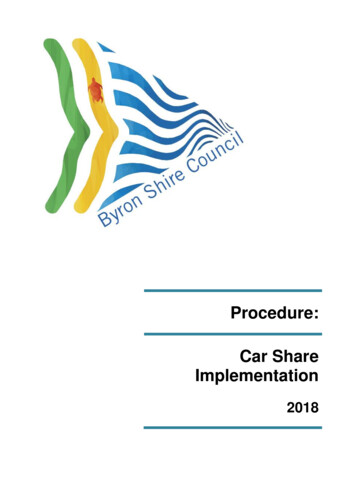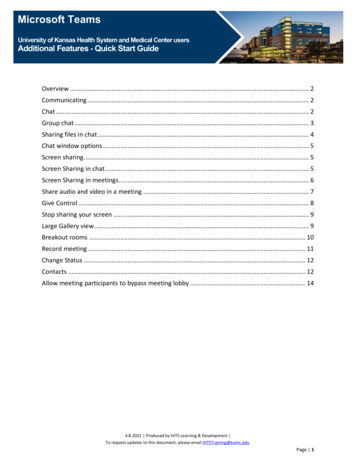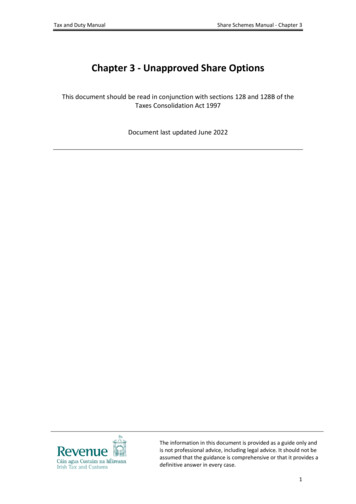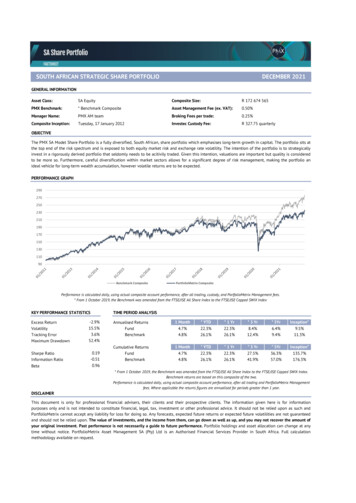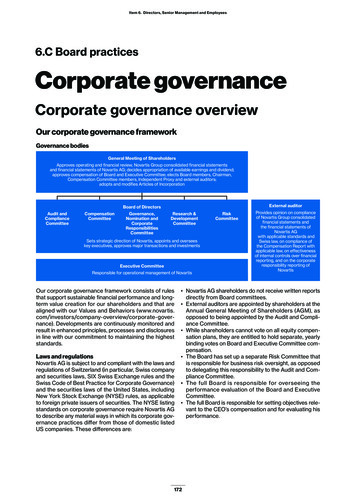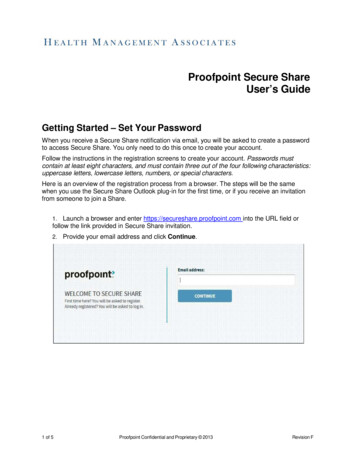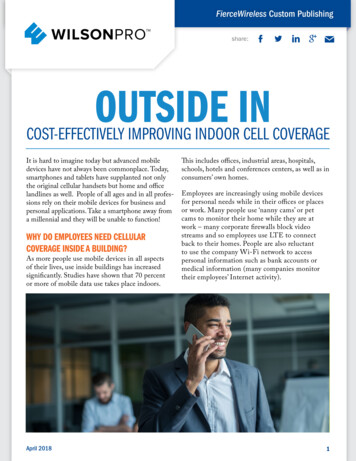
Transcription
OUTSIDE IN:COST-EFFECTIVELY IMPROVING INDOOR CELL COVERAGEFierceWireless Custom Publishingshare:OUTSIDE INCOST-EFFECTIVELY IMPROVING INDOOR CELL COVERAGEIt is hard to imagine today but advanced mobiledevices have not always been commonplace. Today,smartphones and tablets have supplanted not onlythe original cellular handsets but home and officelandlines as well. People of all ages and in all professions rely on their mobile devices for business andpersonal applications. Take a smartphone away froma millennial and they will be unable to function!WHY DO EMPLOYEES NEED CELLULARCOVERAGE INSIDE A BUILDING?As more people use mobile devices in all aspectsof their lives, use inside buildings has increasedsignificantly. Studies have shown that 70 percentor more of mobile data use takes place indoors.April 2018This includes offices, industrial areas, hospitals,schools, hotels and conferences centers, as well as inconsumers’ own homes.Employees are increasingly using mobile devicesfor personal needs while in their offices or placesor work. Many people use ‘nanny cams’ or petcams to monitor their home while they are atwork – many corporate firewalls block videostreams and so employees use LTE to connectback to their homes. People are also reluctantto use the company Wi-Fi network to accesspersonal information such as bank accounts ormedical information (many companies monitortheir employees’ Internet activity).1
OUTSIDE IN:COST-EFFECTIVELY IMPROVING INDOOR CELL COVERAGEAnd of course, companies are increasinglyencouraging employees to use their own mobiledevices for work reasons – this is more convenientfor the employee and may be less expensive for theemployer. Hence, the so-called Bring Your OwnDevice (BYOD) trend is increasing where theemployee chooses their own smartphone and/ortablet, pays for the service and then expenses thebusiness use back to the employer.BYOD has resulted in a greater mix of cellularservice providers being represented in a typicaloffice building. In the past, one or two of the majorcellular operators would have a ‘corporate’ deal witha large company, meaning that all of the employeeswould use the same cellular provider. But with theBYOD trend, employees are free to select their ownsmartphone and service provider, hence a greatermix of service providers being used in a building. Aswe shall discuss later, this is an important point.WHY DO CELLULAR SIGNALS NOT REACHINSIDE BUILDINGS?Unfortunately, the RF signals that connect to oursmartphones and tablets have problems penetratingmost modern buildings. RF signals are blocked bymost metals, reflected by energy efficient windowsand are dispersed by water. A typical commercialoffice building uses steel in its construction, hassteel rebar in the concrete walls and is more thanlikely to have heat-reflective windows. All of thesefactors mean that cellular signals will have a hardtime penetrating the skin of the building and theemployees will subsequently have poor, or no,cellular connectivity.The problem gets worse for some cellular serviceproviders. In general, lower frequency cellularsignals penetrate objects better than higherfrequencies. For example, the initial LTE networkswere built using 700 MHz spectrum, whichpenetrates walls, glass and buildings in general farbetter than higher frequencies. But cellular serviceproviders are now building networks using higherfrequencies and more buildings are making use ofenvironment construction. For example, buildingsApril 2018FierceWireless Custom PublishingCASE STUDY 1:Metropolitan Market, an award winning grocery storechain based in Washington, was two months away fromopening their newest branch when they discovered therewas very poor cellular coverage inside the new building.The solution was to deploy WilsonPro Pro 70 Plus Selectboosters with 14 indoor antennas. The result was four orfive bars of LTE signal in all parts of the store on all majorcellular networks. And everything was designed, installedand tuned prior to the grand opening!that are LEEDs certified (Leadership in Energy andEnvironmental Design) are a big trend across thecountry (and are required in some cities) but thesedesigns are very good at blocking cellular signals,as well as heat and cold. Interference from otherwireless networks can also impact the in-buildingcellular experience.Jeff Gudewicz, chief product officer at WilsonPro,notes that most people see poor in-building cellularcoverage “as a carrier problem”. Typically, WilsonProfinds that employers will “not pay for a carrier-gradesolution” and that the “problem is pushed down tothe commercial building owner”.Solutions to the in-building cellular coverageproblem have been available for some time in theform of Distributed Antenna Systems or DAS.Essentially, these systems use a dedicated cellularbase station connected to antennas inside thebuilding to provide service. But the systems typicallyonly work with one or two cellular service providers’frequencies – in other words, to get service from allfour of the major cellular carriers, up to four DASwould be required. This obviously adds to the costand complexity involved with these systems.THE SIGNAL BOOSTER SOLUTIONAnother effective, and far more cost effective, solutionis to use a signal booster to provide coverage insidea building, such as those provided by WilsonPro. Asignal booster simply has an antenna on the outside ofthe building that receives the available cellular signals,Continued on page 42
We can bringoutside cellsignal inside.Call us or visit our website to learn moreabout getting stronger cell signal in yourbusiness or office building.1-888-503-5329www.wilsonpro.comWilsonPro Pro 1000Boosts 4G LTE up to 35,000 sq. ft.3 year warranty from PurchaseFree custom system designwww.wilsonpro.com1-888-503-5329
OUTSIDE IN:COST-EFFECTIVELY IMPROVING INDOOR CELL COVERAGEFierceWireless Custom PublishingContinued from page 2amplifies them and then rebroadcasts throughout thebuilding. Signal boosters are licensed by the FCC andare approved for use with all of the cellular serviceproviders’ networks.Note that the signal booster does not have to receivea strong RF signal to be effective. On the contrary,the cellular signal outside can be very poor (such asin places far away from the cellular tower) and thesignal booster will still be able to receive the signal,amplify it and provide coverage inside the building.The signal outside of the building therefore does nothave to be strong in order for the signal booster tobe effective.CASE STUDY 2:CHI St. Luke’s Health Memorial Hospital in Lufkin, TX,which was originally constructed in the 1940s andexpanded through the early 2000s. This meant thatthe hospital had areas of very poor cellular coverage,with doctors and nurses regularly complaining aboutthe ability to get a cellular connection. A custom signalbooster system was designed that provided coveragein the main problem areas and limited interferencein critical care areas of the hospital. The result washappier healthcare staff, patients and visitors.Signal boosters offer some very important benefits: Carrier agnostic – since the signal boosteramplifies all of the available frequencies fromall of the major operators, a single system canimprove the coverage of all service providersinside the building. Hence, in companies that askemployees to BYOD, all of the service providersare represented and all employees can use theirsmartphones. Equipment owned by the building owner/manager – the signal booster acts independentlyof the cellular service provider (remember it issimply amplifying the available signal) and islicensed by the FCC. Hence the equipment isowned and controlled by the building owner ormanager and not the cellular operator. Highly customizable – the signal booster caneasily be configured to provide coverage in specificareas or zones of the building. For example, in ahospital, coverage is not required in an operatingtheatre or intensive care unit, but would be neededin the main ward, nurses’ stations, restaurant,etc. In this case, the signal booster can be easilyconfigured to provide coverage only in therequired areas.Continued on page 6April 20184
OUTSIDE IN:FierceWireless Custom PublishingCOST-EFFECTIVELY IMPROVING INDOOR CELL COVERAGESPONSORED CONTENTHOW BUILDING MATERIALS AFFECT CELL PHONE SIGNAL PERFORMANCEPHIL BLOOMBERG, Vice President of Commercial Sales, WilsonProMost of us own a cell phone Witha wealth of mobile possibilities atour fingertips, it’s hard not to expectstrong cell reception all the time. Yet, we’ve allexperienced the occasional dropped call or lost signal.While this can be frustrating, it’s not always the cellcarrier’s fault. Often, there’s just something betweenthe cell tower and you.OBSTRUCTIONS TO A GOOD SIGNALCellular signals emanate from cell towers. Althoughthere are countless towers in most developed areas ofthe country, there are several reasons that signals maynot be reaching your device.HOW BUILDING MATERIALS BLOCK SIGNALSAlmost any large object built by humans can interferewith cell phone connectivity. Since we spend a gooddeal of time inside, we depend on strong receptionindoors. Yet, radio frequency (RF) signals cannot filterthrough materials like metal or concrete. Instead,large buildings or even the walls of your office candeflect or distort signal waves. That’s why driving intoa parking garage will almost always disrupt your cellreception—because suddenly the signal has to dealwith numerous thick concrete walls. Distance: If you’re in a remote region with few celltowers, you may just be too far away for a strongsignal to reach you.Other building materials like wood, brick, stone,shingles, and drywall can have a similar effect,weakening and often blocking signals completely.Even glass—especially energy-efficient windowscoated in metal-oxide—can cause signals to bounceright off the surface. Terrain: Mountains, hills, and bluffs can all stand inthe way of the tower and your device, absorbing thesignals before they reach you.Generally speaking, reception will almost always bebetter outside a building than inside. So how canindoor cell reception be improved? Vehicles: The metal and glass materials of a vehicleprovide protection, but also can prevent cell signalsfrom getting in.CELL SIGNAL BOOSTERS BRING THE OUTSIDESIGNAL INSIDE Vegetation: Thick forests, tall trees, and othervegetation can form natural barriers to signal waves. Atmospheric conditions: Turbulent storms, thickfog, and other weather conditions can easily disruptcell signals. Man-made obstructions: Brick, concrete, and steelmaterials in bridges, buildings, and other man-madeobjects are notorious cell signal obstructers.All these things can prevent cell signal from reachingyour phone, resulting in poor reception. Man-madebuilding materials are especially good at blockingout signals.April 2018Cell signal boosters—also called bidirectionalamplifiers—can make a big difference when it comesto bringing a cell signal from outside to indoors.These devices use antennas to take signal outside thebuilding—even a weak one—and bring it indoors.Then, the booster amplifies the signal and broadcastsit inside, bringing a better signal within range of yourphone. When you make a call, it works in the oppositedirection by transmitting an amplified back outside tothe cell tower.Contact us to learn more about how a cell signalbooster can improve your building’s reception andcreate a custom design to meet your needs.Phone:1-888-503-5329Website: www.wilsonpro.com5
OUTSIDE IN:COST-EFFECTIVELY IMPROVING INDOOR CELL COVERAGEFierceWireless Custom PublishingContinued from page 4 Focus on areas of poor or no coverage – manybuildings have acceptable cellular coverage inparts of the building. For example, it is notunusual to find good coverage in the first tenfloors and poor or no coverage in the higherfloors, basement, inside rooms or parking garage.In these cases, the signal booster could beconfigured to provide coverage only in those areasof poor coverage – this makes for a very costeffective solution. Cost effective – signal boosters cost a fraction ofa DAS, are easy to install and can be reconfiguredor expanded as needed.THE IMPORTANCE OF INSTALLATIONWhile a signal booster is quite simple in concept,the execution within the building is very important.In order to be fully effective, the signal boosterinstallation must be carefully designed and installedby trained, knowledgeable technicians. In the past,some signal boosters were installed incorrectly andtherefore did not perform as expected.To address this problem, WilsonPro has establisheda training program in Dallas, Texas to certify signalbooster installers. The program is affectionally called‘Wilson University’ or ‘WilsonU’. The programtakes two days to complete and covers all aspects ofdesign, installation, test and trouble shooting. SinceSeptember 2017, WilsonPro estimates 120 installersCASE STUDY 3:Sports arenas present some of the most challengingRF environments – many are old buildings that blockcellular signals and yet they are filled with fans whowant to use their smartphones throughout the game.Such as example is Williams Arena (“the Barn”),home of the University of Minnesota men’s basketballteam, which was built in 1928. As a result of theold design and construction, there was no cellularsignal in the team locker room and offices, locatedin the basement of the building. The solution was aWilsonPro signal booster and indoor antennas in theproblem areas. Now, cellular signal is strong and thecoaches and staff are finally able to make calls toteam members and recruits.have been certified by WilsonU. In total, WilsonProhas more than 500 certified installers across the U.S.DO I NEED A SIGNAL BOOSTER?This is a question that many commercial buildingowners and managers are asking. The answer isvery simple: if your building has areas of pooror no cellular coverage, the answer is Yes! Signalboosters provide a very cost effective solution forproviding cellular coverage throughout a buildingfor all cellular service providers. Signal boosters canbe configured to provide coverage as needed, aresupported by a network of certified installers and areowned by the building owner/manager. lWilsonPro is a leader in wireless communications infrastructure,dedicated to delivering mobile phone access for everyone,everywhere. Each booster is designed to enhance signal fromcarrier networks, significantly improving coverage in commercial buildings. The boosters come equippedwith patented technology to protect carrier networks. All WilsonPro products are designed, assembled andtested in the U.S.A. For more information, visit www.wilsonpro.com.SeptemberApril2018 20146
it inside, bringing a better signal within range of your phone. When you make a call, it works in the opposite direction by transmitting an amplified back outside to the cell tower. Contact us to learn more about how a cell signal booster can improve your building’s reception and create a custom design



